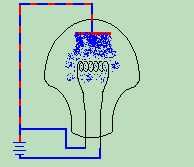


|
What test equipment you will need in electronics, depends quite a bit on what specific job you'll be doing. A telephone technician might need a telephone "butt-set", but wouldn't need a satellite finder. On the flip side, a satellite installer has no need for the butt set. There are certain tools that cross over from one job to another though. I aim to try to explain what many of them are, and if possible, give you some basic schematics for how to build the simpler ones. Multimeter:Every electrical job will sooner or later need a multimeter. The basic multimeter has 3 functions:
The Ohmmeter function will of course measure the resistance of a circuit. Again - range is important, and you don't want to be in a 1 MΩ range if you are measuring 3μΩ. You must have the right meter for the job, as well as the right range being used on that meter. Most technicians and engineers prefer a fluke meter, but if you are on a harbor freight budget - their meters can do the same job if you are up on your technique. Remember - either the man makes the tool work, or the tool makes the man work. The Ammeter function of a multimeter will cause more problems than any. First - to measure Amperes on most meters, you have to use the meter in SERIES (not parallel) with the circuit being tested. In addition, by doing so, you may be exposing yourself (and your meter) to dangerous currents. Often the meter has a 2 Amp fuse in line with it. If it blows.... figure out what is wrong before you continue troubleshooting... it may have just saved your life! Depending on your meter, you may have many other functions which you should at least familiarize yourself with. These may be temperature, light, or sound metering. It may read the beta of a transistor, or capacitance of a capacitor. All these functions may come in handy for some specific use. Whether you use them regularly or not, you should TEST every function on your meter once in a while, just to keep yourself familiar with how it works - for when you do occasionally need to use that function in a real-world situation. Fox & HoundThe Fox/Hound (toner/sniffer) is a great tool for many different jobs where you might need to trace down a specific wire in a bundle. Before the Fox/Hound was "invented" I used to use an "audio tone generator" on one end of a cable, and a "signal tracer" on the other end. It worked quite well for tracking down wires, as well as for tracing out amplifiers in an audio circuit. In a real pinch, a battery and a small light bulb with aligator clips soldered to it can suffice.Logic ProbeWhile many folks will laugh at you if you break one of these out now - it is a very functional method of tracing down problems in data lines. I used to use them regularly to trace out RS-232/485 lines, and see no reason why they wouldn't work today on cat 5/6 or USB systems.Power SupplyI've used power supplies in every lab I've set up, albeit I have also found that a good 9V battery (or two of them in series forming an 18V supply) can pack quite a punch for a short period of test time. The advantage is that they are disposable, and provide a very good, clean DC source. The disadvantage is that as you use them, they diminish in current and voltage. |

| (On The Following Indicator... PURPLE will indicate your current location) | ||||||||||||||||||||||||
| 1 | 2 | 3 | 4 | 5 | 6 | 7 | 8 | 9 | 10 | 11 | 12 | 13 | 14 | 15 | 16 | 17 | 18 | 19 | 20 | 21 | 22 | 23 | 24 | 25 |
| 26 | 27 | 28 | 29 | 30 | 31 | 32 | 33 | 34 | 35 | 36 | 37 | 38 | 39 | 40 | 41 | 42 | 43 | 44 | 45 | 46 | 47 | 48 | 49 | 50 |
| 51 | 52 | 53 | 54 | 55 | 56 | 57 | 58 | 59 | 60 | 61 | 62 | 63 | 64 | 65 | 66 | 67 | 68 | 69 | 70 | 71 | 72 | 73 | 74 | 75 |
[COURSE INDEX] [ELECTRONICS GLOSSARY] [HOME]
| Otherwise - please click to visit an advertiser so they know you saw their ad! |
